#creating new worlds. creating a vessel for the player. creating connections
Explore tagged Tumblr posts
Text
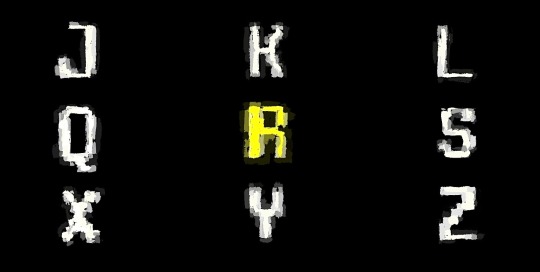
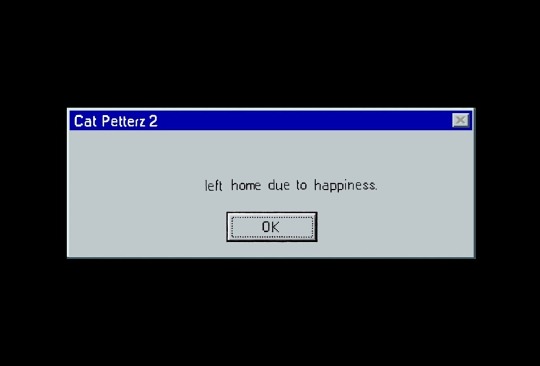
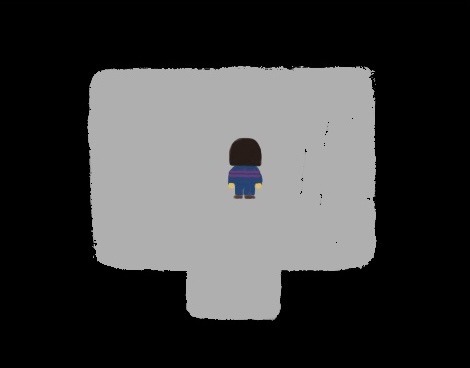

as if it was never there at all.
#undertale#deltarune#utdr#gaster#ok little bit of rambling bc ive been catching up on a LOT of deltarune stuff#something something guy(s) who cant be perceived without also ceasing to exist#i had the thought yesterday that. gaster is sort of the anti-chara in a way. if you say his name he ‘disappears’#the game crashes or resets etc. literally the opposite of invoking chara lol#plus how chara is so associated with deletion of worlds. and here gaster is wanting to create new ones#creating new worlds. creating a vessel for the player. creating connections#and its so much more sad when you think about how deltarune is like. fundamentally his attempt to connect with the player#he can maintain a connection with us. but we can’t see him. or show him his own name. or acknowledge his identity in any way#or else that connection will be severed. or he’ll disappear. or he’ll cease to have ever existed#mystery man goes away the moment you interact. egg man was never there but he gave you an Egg#etc etc#the white egg noelle was given in her game makes me think about this too because#that egg remained there the whole time she was afraid of it. it couldnt be thrown away. it wouldnt hatch. it was just There#and then when she comes back later and decides to take care of it like any of her other pets. THEN it disappears#’_____ left home due to happiness.’#how do you form real lasting connections when the connection itself makes you disappear
268 notes
·
View notes
Text
oblivion theory is the best deltarune theory bcuz every inconsistency with the legend and the knight and everything is just explained away by "this whole premise is fabricated so you'll keep playing the game forever" and it also makes actual perfect sense
#literally a ride or die oblivion theory truther i am 99% sure that its whats actually going on bcuz it just makes too much sense and it#connects the pieces in such a all-encompassing way that ive never seen another theory successfully do before#the virgin ''whats up with the knight whats up with the roaring this doesnt make sense'' vs the chad ''gaster's experiment is creating#a game within a world that is not a game and making up a fake prophecy to keep you playing through dark worlds and sealing them#forever and the knight is the vessel (the embodiment of your desire to consume content) literally making the game so that u can play it''#read the oblivion theory doc by wandydoodles if you havent already for the love of god. im so serious#thinking about it makes me crazy. the omori parallels too (which they bring up). how the whole premise of ''saving basil'' is literally#just made up for sunny (and you) to keep exploring headspace forever. a wild goose chase of a rpg premise#thats exactly what i think is going on in deltarune's dark worlds in line w this theory cause it just makes too much sense#serena.txt#ftr i am not new to oblivion theory i read it months ago. im just gushing about it rn cuz the lets player im watching is speculating#about the knight and im just like heh heh. does she know?
12 notes
·
View notes
Text
i've seen people joke about it but... is there any kind of consensus within the community regarding the player and Gaster's relationship? is it something that everybody just naturally agrees on and doesn't talk about it because there's no point to it or am I just going crazy on my own??
like yeah sure, first and foremost, we have the tweets written by Gaster himself and addressing the player, either rejoicing in seeing us showing the same kind of interest and fascination in him that he does for us, or describing how wonderful and special that "connection" we have is, how it makes him feel to be connected with us and how specifically "beautiful" and "exciting" it is for him to enter in contact with us.
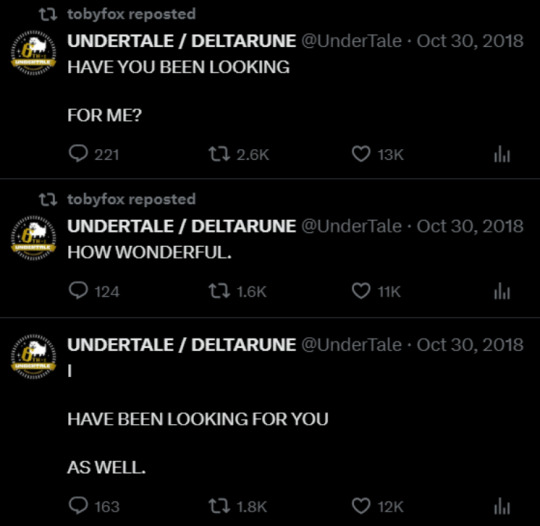
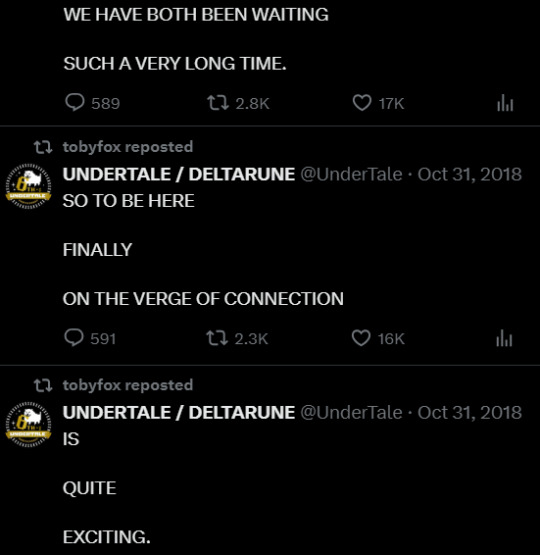
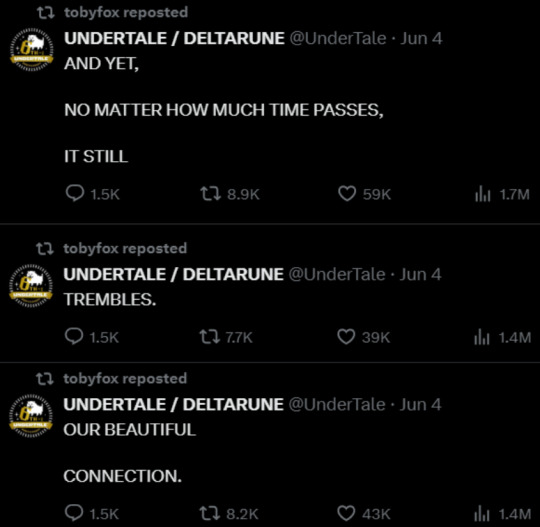
Or talking about HE and WE specifically feel about each other, and going on about creating something together, as partners- i mean as a team.
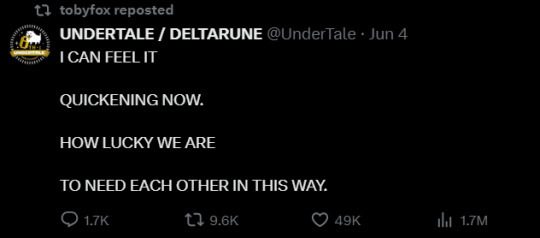

And then we have the Goner Maker sequence, during which he keeps going on and on about how "wonderful" our creation is, guiding us step by step towards the realization of the EMBODIMENT of a player's freedom in a video game : their own avatar. Gaster is the only one in this game who is actively giving the player that much freedom, who is trying so hard to accomodate the player, to fulfill their wants and needs.
(unsure if it still needs to be said nowaday but no, the person discarding our vessel isn't Gaster, they talk in a different typer (given the fact Gaster's typers are always 666 or 667, it seems important to note that this new person talk in typer 2), not using any upper-cases, and not remotely talking in the same way (in japanese even more obviously than in english : Gaster talks in broken katakana japanese with some kanji while the other voice talk in hiragana and complex kanji. they also don't use the same second person pronouns when talking to the player), so yes, Gaster is STILL the character who seems to (at least in appearance) want THE MOST the player to be the most confortable possible, out of every other character in this game)
This idea of Gaster giving the player AS MUCH freedom as he can, in a world that seemes to be DESIGNED for us not to have any freedom, is first obviously supported by the way he is takling about "CREATING A NEW FUTURE" with our help, suggesting that OUR power as a player should be able to change the future and that it is in his interests for us to find the freedom leading us to that "NEW FUTURE", but it is also implied with the fact it seems that it is Gaster who is giving us access to three different save files, as we can see him talk and comment each one of our actions in the menu of an incomplete Ch1.


Gaster is ON THE PLAYER'S SIDE. or at the very least, he's doing a very good job at pretending he is. And it makes sense for him to be the only character who seems to INCONDITIONALLY support the player : he's the only one who seems to truly understand WHAT is the player, at least more than every other characters in this game. (there's an argument to be made about Ralsei, who seems to also only want the player's happiness, but 1. he doesn't really have the power to accomodate the player like Gaster does, so each one of his attempt to please us either end in just giving us fake hope, or being cancelled out by Susie (who seems to naturally oppose the player whenever she does something), and 2. unlike Gaster, Ralsei is CLEARLY suffering from always trying to please everyone else, especially the player, for whom he believes he needs to play the role of a LITERAL background character who's only here to serve and make them happy. Ralsei suffers from trying to please the player, while it seems like Gaster only gets enjoyment out of it, repeatedly stating that being connected to us is as wonderful for him as it is for us)
And the way Gaster views the player has become a bit clearer with his Ch3 and 4 messages, that can be used on top of his usual Game Over dialogues to suggest that he is watching us play at all times, is rooting for us, knows things about how this world works that we don't and is willing to give hints when he feels like it is necessary, and can be genuinely impressed by "our power", supposedly our determination and/our our pure game skills.
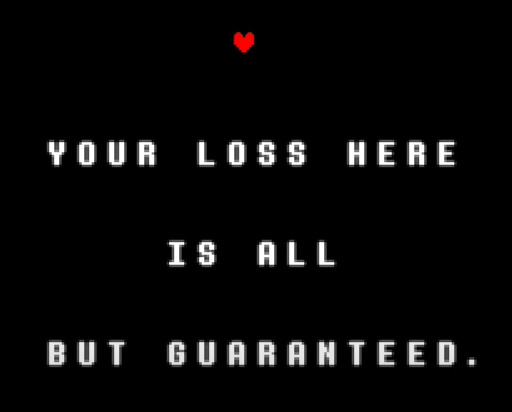


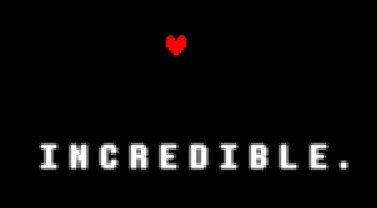
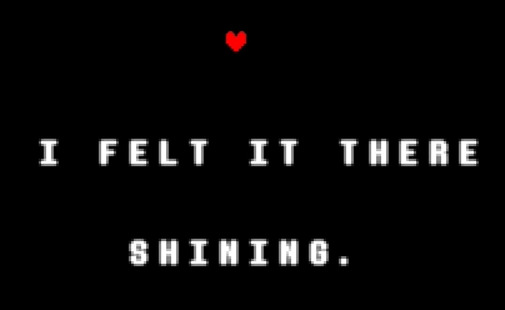

His Game Over message could even be interpreted as him trying to emotionally manipulate us into trying again, even when we told him we've given up, telling us how our absence led the world to be "covered in darkness", before cueing a very sad rendition of his own theme before closing the game after 66 seconds. Bro is literally looking at us through the screen with the saddest look in his eyes trying to coax us into trying again by making us feel bad. Maybe he DOES really need us as much as he says he does.

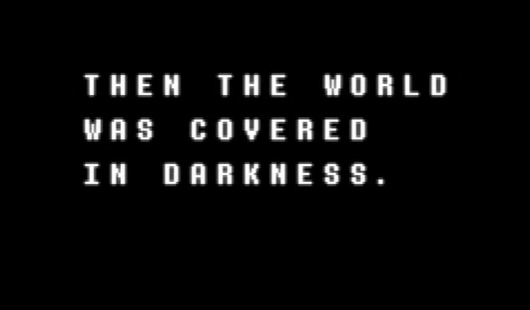
And maybe the most interesting recent dialogues of them all, at the end of Ch4, he congratulates the player for making it this far, quickly mentions how long we will need to wait for the next chapter/connection... Before refering to Deltarune as "HIS" DELTARUNE??

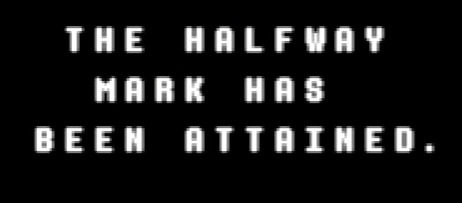


Up until that very moment, Gaster has always talked about "the future", "this world" as a 'team effort', always including us in the realization of it all, making us feel like we WERE an important part of whatever scheme he has in mind... Hell, sometimes he even talks as if THE PLAYER'S actiosn were actually ALSO his ("SHALL WE HASTEN?" against the Knight, when in reality the player is doing all the hard work here), which didn't seem strange because as a TEAM, that kind of way to speak is pretty normal. but in this moment, it somewhat feels like Gaster is trying, or at least thinking about taking ownership over everything "we" have created together. Was it his intention since the beginning, or is he just stating to love this game/world so much he's subconsciously seeing it as "his" and having troubles sharing it with the other person who helped reaching its realization? or maybe are we not completely understanding our role in his plan yet?
And all of this, all of this weird undertone of codependant relationship between Gaster and the player, this mutual fascination and genuine feelings for one another, whatever those feelings can be, ALL OF THIS without even talking about the Demon/Angel parallels we could ALSO talk about regarding how the relationship between those two transdimensional entity could go.
Let's assume the player is the Angel. (The Angel is said to "light up the path" of believers, the player's soul's distinctive power is to produce light on its own. The Angel is said to be "watching over" the world and people, the player's pov seems to come from the sky, from "HEAVEN" some could say. The Angel is traditionally represented without facial features, as Noelle and Dess's doll's description at the hospital points out, and the we are unable to see how the Angel looks like in the prophecy, which would make a lot of sense if the Angel was supposed to be the player, someone who, inherently, has to be faceless to represent ALL of us. The player's soul gets trapped under an Angel doll at Noelle's house. The Titan we see in Ch4 uses a lot of the imagery typically associated with the Angel, and first appears with an image suggesting a "real human face". That is SOME of the reasons why it's easy to assume the player is the Angel, at least in SOME versions of DR's reality (for example it would be possible for Noelle to take the role of the Angel in a Weird Route or something, the same way the Angel was two people at the same time in UT ; one benevolent Angel, and one Angel of Death, depending on the run the player is doing)).
Gaster has always been associated with demonic symbolism, the most obvious of which being the repeated connection he has with the number "6" : the typer associated with him is 666, in both UT and DR, his hidden stats in UT are filled with 6s, each one of the funvalues directly calling him by name are all happening between 61 and 65 (which is also why it is so commonly accepted to say that the mystery man from the funvalue 66 is supposed to represent Gaster himself in some way), the theme DARKNESS FALLS, as previously mentionned, is 66s seconds long, etc...
Interestingly enough, supporting the interpretation of these "666" as being the Devil's number, Gaster also made an appearance in the "demon text" of UT during a very short period of time : alongside a text CLEARLY written by Chara, "the demon who comes when people call its name", another line appeared in PRECISELY the version 1.05A of the game, saying "HE IS". (for more information on the demon texts if you are interested here is a post by Underlore talking about it)
It makes sense for Chara to be present in the DEMON text, because they call themself a demon, and it makes sense for Gaster to be there as well, as he's so often associated with the number 6. and ironically enough, while Chara is the demon who comes when people call its name, when we first name them at the beginning of the game, we are UNABLE to write or hear the name of Gaster in most playthrough. In a way, it's as if he's specifically a foil to Chara, the demon who comes when people DOESN'T call its name, haha.
And this makes sense with WHAT Chara is supposed to be : Chara is the player's completionist will, what pushes them to conquer and consume every last bit of a game, leaving nothing left behind them, metaphorically "destroying" worlds for their own entertainment. But, because of his very special status in the game, Gaster just cannot be "consumed" like every other content can ; he is often the very last thing keeping people interested in UT, when everything else has been read and analyzed, only him stays "unsolved", everything one can know and believe to understand about him feeling like a bottomless pit of endless possibilities. Literally the one thing the player needs to satiate Chara. Endless content, because incomplete.
Gaster has always given the player what they wanted, ever since UT. He is in a way the opposite force opposing the player's will to SEE and DO everything, because he is the content they will never be able to SEE and TRULY interact with, but this is this exact force that makes the player feels so connected to the world ; if the content is seemingly endless because unreachable, then the illusion of a fictional world being infinite is achieved. and as a result, the player becomes obsessed with that world that seems oh so real.
Because of this duality between these two, it could be easy to suggest the possibility that Gaster isn't "just" a demon, but The Devil, acting as a counterpart to The Angel, the player. After all, it is Gaster with whom we made a suspicious deal at the very beginning of DR, giving him our SOUL regardless of what the consequences would be.

Who else would offer a deal with such absolute conditions than the Devil itself, the one who is represented by the number 666, the one who we are told to "beware" from the very first time we hear about him.
All of this to say i do not think it would be so wild to assume that, with everything that we know about how the player's and Gaster's goals, wants and ENTIRE EXISTENCES allign but also complete one another, it wouldn't be so out there to believe that maybe, similarly to how Flowey in UT became obsessed with the player because they were the only person existing at a similar plane of existence as him, the player and Gaster would develop very strong feelings for one another, because they are the only ones in this fictional world who see it as a fictional world, the only ones who understand one another, and who can help each other effortlessly, simply by following their own instincts.

TL;DR i ship the player and Gaster and i made it everybody else's problem
#was there a point to all of this#i might just be insane#deltarune#deltarune gaster#wd gaster#deltarune player#player deltarune#<- so cool we're all collectively acting as if they were a character in-game#never done a ship manifesto before... is this how you do it guys. am i doing it right.#if anyone reads all of this im genuinely so sorry for you#deltarune spoilers#deltarune chapter 3&4 spoilers#it is 3AM and im writing about gaster x player because that's the most meaningful thing i can do in my life#go to bed aster#<- theory/analysis/rambling tag ig
93 notes
·
View notes
Text
W. D. Gaster x Player male reader
Ficlet
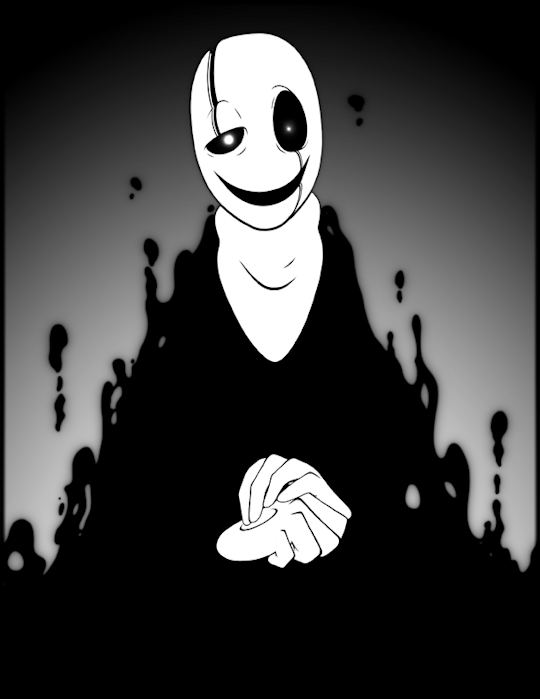
Ive had this idea for a while, that the Player, aka the soul we control, gaining some kind of body or upper sentience, if that makes sense? Aka, both of them are kinda shapeless but not really.
This takes place some place between Undertale and Deltarune, smth like the void we see at the start of chapter 1 of Deltarune. I saw somebody have a theory that its Gaster telling us to create a vessel, so ill go with that.
Ive been a Gaster dickrider for years, but this is the first time actually writing him. Ive only wrote some sans and papyrus x reader stuff, somewhere. Its deleted now.
I was feeling a little goofy, so yes, there's wingdings in this. I added translations, of course.
It was hard to explain, the world between worlds, of existing but not really, to be everywhere and nowhere at once. You were simply too determined to die, even after everything was said and done, and Frisk and the monsters of the underground joined the surface and got to live their lives to the fullest.
You knew you couldnt stay. Your continued existence in this world would keep the loop going. The only way to let them all be at peace was to leave. At that time you had only just been a soul.
A powerful, glowing, bright red soul, pouring determination so thick that reality was fraying at the edges at times. But as you floated between worlds, your determination only seemed to brew, and with you, you grew.
During these explorations you met Gaster, or perhaps parts of him, different parts and pieces of one man split across time and space. He was strange, really strange, but endearing.
Being the only two beings stuck beyond time and reality itself did cause you two to get closer, and Gaster had been so intrigued when your heart-shape started changing.
Gaster, being the scientist he was, only mumbled out a slurred and blurred “☞︎♋︎⬧︎♍︎♓︎■︎♋︎⧫︎♓︎■︎♑︎” (Fascinating), as he cradled your glowing form in his melted, glitching, solid, liquid, there but not, hands. They were boney, with large circular holes in them. Big enough for you to float through.
Until your shape changed enough. First it was tendrils, like a droplet of coloring in water, how it spreads and dilutes. At first you two both feared you were ceasing to exist completely, that was before the tendrils solidified and started taking another form.
The knowledge you had of humans, as you were sure you might have been one once, let you know your new form looked like a nervous system. It would have creeped you out, had you still possessed that ability.
It didnt help that Gaster seemed to become more solid than you had ever seen him, the dark pits that were his eyes, flickering with small lights like weak candles.
“☟︎□︎⬥︎📬︎📬︎📬︎ ⬥︎□︎■︎♎︎♏︎❒︎♐︎◆︎●︎📬︎ ✋︎ ♒︎♋︎❖︎♏︎ ■︎♏︎❖︎♏︎❒︎ ⬧︎♏︎♏︎■︎ ♋︎■︎⍓︎⧫︎♒︎♓︎■︎♑︎ ●︎♓︎🙵♏︎ ♓︎⧫︎” (How wonderful. I have never seen anything like it), he buzzed, his voice there, but also not, fading in and out like a phone call with bad reception.
You almost felt embarrassed as the many tendrils that made up your being wound around his hands and arms, or what existed of them in this very plane of existence. Had Gasters own form not turned goopy and runny, like you knew it did when he was flustered.
There was no sense of time where you two found yourself. This meant you got to grow and develop as much as you pleased, your being taking a form that fit you the best. Much to your and Gasters shared interest, that form was like that of a knight.
Large and terrifying to enemies, but comforting to those who needed protection. It even had a long flowing panaches on your “helmet” (think Igris from Solo Leveling). The armor wasn't truly armor, it was... you. It was hard to explain, and made reality start bleeding together if you thought too hard, so you didn't.
At least Gaster was downright tickled pink at your preferred form turning out to be a glowing red knight. His connection to... well... everything was more vast than you, and you had a feeling he was giggling about some inside joke.
Especially in the way he would always cover his mouth and turn into shimmering waves of stars and space when he called you his “😐︎■︎♓︎♑︎♒︎⧫︎” (Knight). It felt like something you should know but... you just didn't.
Having a physical body was great, as it allowed you to hold the pieces of Gaster that could exist on your plane. It was especially great when you guys realized your determination was so powerful it made him more solid.
You guys couldn't really kiss like most couples. Your face was a helmet, and his was stuck in a helmet grimace, when he could actually create a solid enough head to begin with.
It was a good thing you two didn't need that, as you two got away with simply coiling your beings together, like two snakes going at it, but with a lot more tendrils, slipping in and out of being.
You were still so confused when Gaster was cuddled up against your armored chest, one of his many hands drawing shapes on the chest plate. Giggling about his “😐︎■︎♓︎♑︎♒︎⧫︎” (Knight).
Especially when Gasters raspy melting voice giggled out a “🏱︎♏︎❒︎♒︎♋︎◻︎⬧︎ ♏︎❖︎♏︎■︎📬︎📬︎📬︎ ♋︎ ☼︎□︎♋︎❒︎♓︎■︎♑︎ 😐︎■︎♓︎♑︎♒︎⧫︎” (Perhaps even... a Roaring Knight), before he started giggling again, his edges blurring together as his hands slipping through you like smoke.
Gaster never made much sense, but you guessed the same could be said about you. So, when Gaster one day appears, only through his voice this time, and asks you to create a vessel, you go along with it.
There is a pull in your SOUL, or at least part of you, that needs to go somewhere, and you know Gaster is leading you.
Even as the vessel is discarded, you just huff a chuckle to yourself and let a small piece of yourself go, following along with whatever adventure Gaster seems to need you on.
The large part that remains with Gaster in the in-between, does shivering as his ghostly affection brushes over that tiny heart shaped piece before its sent on its way. What a nerd... but he's your nerd...
#male reader#undertale#deltarune#w.d. gaster#gaster#undertale gaster#deltarune gaster#player!reader#undertale x male reader#undertale x reader#deltarune x male reader#deltarune x reader#w.d. gaster x male reader#w.d. gaster x reader#gaster x male reader#gaster x reader#undertale imagine#undertale headcanon#deltarune imagine#deltarune headcanon#w.d. gaster imagine#w.d. gaster headcanon#wd gaster x male reader#wd gaster x reader
71 notes
·
View notes
Text
Writing Notes: Mystical Items & Objects

Examples in Mythology and Literature
Pandora's Box
The god Prometheus stole fire from heaven to give to the human race, which originally consisted only of men
To punish humanity, the other gods created the first woman, the beautiful Pandora
As a gift, Zeus gave her a box, which she was told never to open
However, as soon as he was out of sight she took off the lid, and out swarmed all the troubles of the world, never to be recaptured
Only Hope was left in the box, stuck under the lid
Anything that looks ordinary but may produce unpredictable harmful results can thus be called a Pandora's box
Hermes' Winged Sandals
Also called the Talaria of Mercury
Are winged sandals, a symbol of the Greek messenger god Hermes (Mercury)
They were said to be made by the god Hephaestus of imperishable gold and they flew the god as swift as any bird
Cintamani Stone
Also referred to as the Chintamani
A wish-fulfilling stone that features across both Hindu and Buddhist religions
The stone features as one of many Mani Jewel (i.e., several gems that are mentioned prominently in Buddhist literature) images that can be found in the scripture of Buddhism
In Hinduism, the stone is connected to the gods Ganesha and Vishnu
Usually, it is depicted as a jewel in Vishnu’s possession known as the Kaustubha
The Kaustubha acts as a sign of divine authority
Arcane Artifacts & Objects
Offer a gateway between time past and time present, bringing layers of ancient history and new-world intrigue to a narrative
Such items are typically represented in fiction as works of long-lost knowledge, primordial features or landmarks, and curious objects of mysterious origin
Often lying dormant until the pivotal moment of discovery, these items invite characters and readers alike into a dance with the unknown
Examples: Necronomicon, Genie's Bottle
Necronomicon
Also referred to as the Book of the Dead
It appears in stories by H.P. Lovecraft
A dark grimoire (i.e., a magician's manual for invoking demons and the spirits of the dead) of forbidden knowledge
Used to open gateways of unearthly powers and cosmic horrors
Genie's Bottle
The classic magical item from mythology, also featured in Aladdin
A vessel of wish fulfillment that often leads to dramatic and unexpected consequences
Doorways & Portals
Doorways in fiction serve as gateways between worlds, dimensions, or states of reality, providing characters with universe-hopping capabilities and genre-defying journeys
These portals, whether physical structures or fantastical mechanisms, open up limitless storytelling possibilities, allowing for sudden shifts in setting and introducing elements of surprise and surrealism
Examples:
C.S. Lewis' wardrobe in The Chronicles of Narnia serves as a secret portal to a fantasy world, bridging the mundane with the fantastical
The eponymous board game in Jumanji transports its players into a wild and perilous jungle adventure, wrenching them from the safety of their living room
Jewelry, Gems, and Garments
Along with other various accessories, these serve several narrative functions, from symbolizing power and status to bestowing unique abilities upon their wearers
These items can act as plot catalysts (i.e. MacGuffins), embody character traits, or hold deep cultural or magical significance within a story’s world
Example: The Amulet of Mara in Skyrim not only reduces the cost of Restoration spells but also unlocks marriage options for the player, integrating gameplay with the narrative
Legendary Objects of Power
Carry with them stories of grandeur and lore, passed down through generations and intertwined with the fates of those who wield them
These are the objects that make or break worlds, bestow immense strength, and are frequently considered among the most powerful items in fiction
Example: Though it's never actually been seen, the Kusanagi Sword from Japanese folklore is a fabled sword that represents valor, said to be endowed with divine powers
Machinery and Technologies
Stretch the boundaries of physics and logic to offer a glimpse into what could be possible in alternate or future universes
These innovations, whether grounded in current science or verging on the fantastical, propel narratives forward and deepen the complexity of the story’s world
Writers can leverage these technological wonders to enhance their storytelling, using them to explore themes of power, ethics, and the human relationship with technology
Example: The body shields in Dune generate a protective forcefield around the wearer—advanced technology that current militaries can only dream of
Mundane Everyday Items
Possess extraordinary storytelling potential to transform the unassuming into the unforgettable
Seemingly ordinary, these objects can surprise both characters and readers, unveiling hidden depths and abilities when least expected
These seemingly mundane objects could fall into unsuspecting hands and create chaos or catalyze a hero’s journey
Additionally, they might only reveal their true nature to those worthy or capable of wielding their power, which can set the stage for narratives that are centered around discovery and mastery
Example: Oscar Wilde’s Portrait of Dorian Grey presents art as a vessel for dark magic, encapsulating the protagonist’s sins while he remains untouched by time
Sources: 1 2 3 4 ⚜ Writing Notes & References
#writing notes#fantasy#mythology#literature#greek mythology#writeblr#spilled ink#dark academia#writing reference#poets on tumblr#poetry#writers on tumblr#writing prompt#fiction#light academia#studyblr#booklr#creative writing#writing resources
156 notes
·
View notes
Text
Slay the Archivist (TMA and STP Crossover AU)
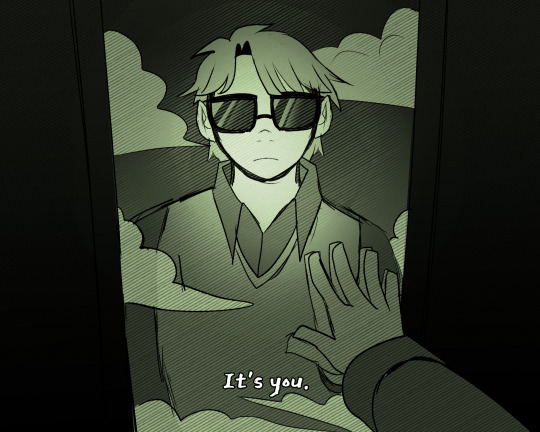
I haven't seen a fully fleshed out Magnus Archives and Slay the Princess Crossover, so as someone whose binged both, its my duty to create it.
Backstory
After the end of MAG200, Jon, Martin, Annabelle/the Web and some remnants of Jonah Magnus/Elias are shunted into the multiverse, and into a new world where they can spread their fear. Being exposed to the Fear Entities in such an upfront way that no other mortals have ever managed to achieve, Jon, as the Avatar of the Eye, is prioritized by the Fear Entities and proceeds to absorb them into his Avatarhood, basically becoming a God of Fear itself. While his old self and humanity isn’t completely gone, it’s certainly much more diluted amongst the new influx of power.
Annabelle of course, as the Avatar of the Web, which was once the Brain of the Fear Entities but has essentially been usurped by Jon, decides to trap him and Martin in a sort of pocket dimension. Both of them forget their names, and have their memories wiped, now convinced they are still working in the Institute and having no memory of their relationship. Using Jonah Magnus as a sort of puppet, Annabelle uses his voice to guide Martin into destroying Jon once and for all.
Speaking of, what is Martin in this case? Martin’s personal connection to the Lonely, Annabelle empowering him with the Web, and Jon subconsciously empowering him through the Eye means that Martin, like Jon, is empowered by multiple Fears, which gives him more of a chance to kill Jon then she does. Yet, Martin still retains his humanity for the most part and therefore Jon's power relates specifically to Martin's own fear, making him a sort of antithesis to Jon: If Jon is the God of The Things That Are Fear, then Martin is the God of The Things That Are Not Fear.
The Construct
Within the construct Annabelle created is essentially a dollhouse-like recreation of the Magnus Institute. Jon and Martin both are in the mindset of their season 1 selves, with Jon being distant and bitchy and Martin being insecure and a bit of a pushover. Both are actually Gods, but have no clue to their true natures.
Annabelle, using Elias’ voice, calls Martin to his office and demands he kills Jon in order to protect the world, taking the role of the Narrator to guide Martin into doing the job right. In the hallway is a knife on a desk, which Martin has the option to take or not.
Jon, being an Avatar of all of the Fears, now has an interesting caveat in that, depending on how Martin chooses to interact with him, his appearance and personality changes in tandem with what they are BOTH afraid of. Jon embodies a different Fear in every route, changing the more he and Martin butt heads.
Because of their godhood and the nature of the Construct, Martin and Jon can’t ever actually die, even if they kill each other; they’ll simply be shunted into a new chapter picking up from the previous one.
Blade VS No Blade
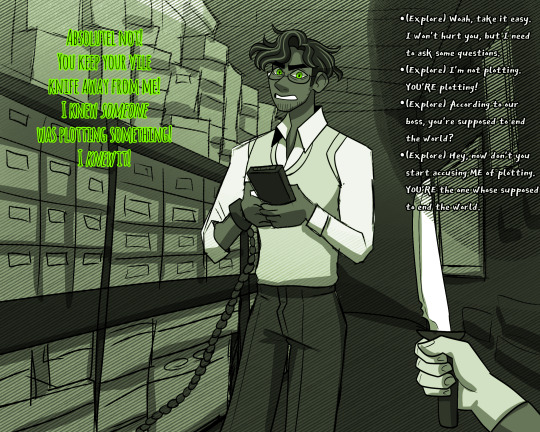
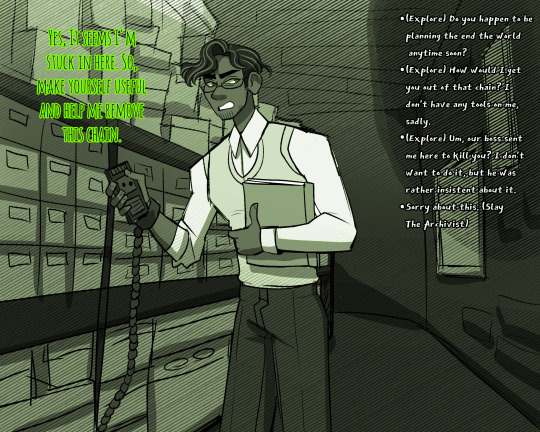
Much like STP, the "Player's" choices alter how Jon appears. If Martin takes the knife, Jon’s demeanor is more like his Season 2 self; paranoid, angry, distrustful and secretive. Without the knife, he acts more like his Season 1 self; incredulous and snobby.
That's it for now, but I'll be expanding on this in the future with the different Fear Vessels.
#slay the princess#slay the princess au#au#tma#the magnus archives#the Magnus Archives jon#jonathan sims#jon sims#martin blackwood#tma martin#Martin tma#the magnus archive fanart#crossover#crossover fanart#crossover au#stp spoilers#stp fanart#elias bouchard#tma annabelle#tma the web#jmart#tma jmart#jmart fanart#slay the archivist au
159 notes
·
View notes
Text
Why is "Magical Mental Illness" ft. Spamton G. Spamton
It's honestly a shame that my delay in playing Deltarune has led to me not making an essay about Spamton already. There are so many things to be said about that wretched little man on every level from character writing to the narrative and gameplay mechanics. And while I would love to be an expert on most of these in order to give a great opinion, I am only a semi-expert in one thing - and that is Psychology in character writing. Even with finally playing the game, it took a few things beyond pure brainrot to get this essay out of me that are important to keep in mind. One, was a video essay I was watching about this very topic which was not sitting well with me. At times the essayist seemed to deliberately negate the in-universe readings of Spamton in order to blunt force certain labels onto him, and at others they hastily stepped over grounds for interesting psychological insights. This then reminded me of the other important aspect, that being some advice my Abnormal Psychology teacher gave my class on what can only be described as an actual blorbo diagnosis roleplay assignment. She advised us to avoid characters from stories too stepped in fantasy because it can at times be near impossible to seriously put a scientific label on that which was meant to be magical through and through. We're not playing Matpat here.
As an avid lover of both fantasy fiction and psychology, I have run into this paradox plenty, to the point I even once had a name for it - "Magical Mental Illness". It is just a fact of the medium that you will often run into characters who express traits discernable as real psychological dysfunctions, but with entirely magical logic behind them. Spamton, in all his spastic glory is a perfect example of this, to the point it is barely even worth pointing out. But what is worth pointing out is how that line between the clinical and magical does not have to be the end of the conversation. My gripe with that essayist is not that they chose an incorrect, haphazard way to look at Spamton, but that it did not provide the most satisfying synthesis. Especially with a game like Deltarune which subtly revels in blurring the line between the real and imaginary for characters and players alike. It is very concerned with how we relate to fiction through how its fiction relates to its own meta-fiction, creating new layers of meaning to explore. Humans have been relying on stories as windows to our souls as long as we've been writing them, and especially as reference for when our souls become troubled. It's only natural that in that legacy, we begin to read about what it even means to read a story.
Kris and the Player: Hand in Unlovable Hand
Before getting too thick into the weeds, it's important to explain what I mean by this double layer of fiction and how it connects to us. In almost all popular stories you have a perspective character or presence to serve as the audience's middle man, and for Deltarune that character is Kris. But Kris is not as passive as the usual protagonist, as they appear to be acutely aware of and tormented by their role as the player's vessel for peering into their world from outside the game. Somehow, this poor 14 year old within their own world has fallen victim to some sort of possession facilitated by a third party beyond them and the player, and the mystery surrounding this predicament and what meaning the story will find in it is one of the pillars of the narrative intrigue. One that ironically draws us into being active participants in this torment of Kris as we seek to understand how to break it for them.
I was actually watching a different video on Kris' backstory when I stumbled across another magical mental illness blunder in analysis that also inspired this essay. The essayist was explaining a part of Kris' backstory told by an estranged friend, Noelle, who describes how Kris used to have a habit of suddenly freezing and staring off into space for some time before coming to again and quietly reorienting themself. As someone watching the video to comprehend the in-universe and meta-narrative implications of this, I was very surprised when the essayist interjected by declaring this evidence of Kris suffering from absence seizures. Unlike the dramatic spastic seizures that typically come to our mind, absence seizures are as Noelle described, where people lose consciousness and freeze in place for periods of time. This interpretation was not useless. It did hint that Kris may have suffered extreme stress during that time in their life, and more importantly, it was a comfort to the essayist who made the connection from their own experience with the trait, but it does cut off discussion on its own. At best absence seizures may have been an active reference Toby Fox used to write the behavior, especially to make it something that people around Kris could attribute to a non-magical source, but in this world of possessions and mysteries that cannot be an answer in itself. Kris is a magical character in a magical context, and no matter what their behavior looks right now, it is more than likely magical mental illness.
Frustrating as those two essayists' reasoning can be, I can't fault the instinct. Honestly as I was watching that video beforehand I was sussing out in my mind a headcanon diagnosis of Kris that could contain the metaphorical strengths of their character and maybe speak some spiritual truth to that disorder and its humanity. One of my first instincts was Dissociative Identity Disorder, but I cringed away from it aware that it is a negative trope to portray alters as adversarial or invasive. But that trope, or more the language of it without the direct clinical label - magical DID - has never stopped being attractive to me, because even if it doesn't align with the psychological truth of the disorder, it does still with a broader metaphor. Maybe its selfish, but when I read of DID, an inevitable theme or story of it arises in my mind that reminds of my personal struggles with identity. How parts of me sometimes felt foreign and cancerous, and how learning to carve parts of those out of me was a silent triumph I longed to express or see expressed in stories around me. In Kris, I see my own middle school age self who lost the superficial childish dreams which defined her and moved through life in a daze as she tried to understand what truly ran her before finding it and taking back control. That thinking can come off as medieval or psychoanalytical, but as a writer I think it can be important to recognize it as a tool of empathy as well. A way for an unafflicted soul to find a root in themselves that at least emotionally blurs the line between themself and this clinically defined "other".
As we'll see with Spamton, this exercise in relatability between players and Kris goes deeper than just the initial experience of struggle, but into that wish to see oneself reflected elsewhere. Deltarune is not a story that needs to have specific discernible labels to its characters' internal struggles, because its not about the answer as much as it is about carrying a question with oneself into another realm. As I or another player may carry insecurities about control of the self into Deltarune, Kris carries their own into the dubiously metaphorical Dark World. As of right now, it is somewhat hard to say whether the Dark Worlds are as real as the life of Kris and their fellow lightners in the Light World, and I doubt this boundary will cease to be toyed with anytime soon. At the end of the first chapter we can see the hint that the card and board game themed Dark World was related to a closet of alike toys, and the connection was made explicit when Kris is told to bring the characters - the darkners - of that previous session into a new ground established in chapter 2's computer lab. But, at the end of each chapter, just as the player could begin to say to themself it may have all been a dream, Kris tears the player's will out of their body and reminds them how willing this game is to confuse the borders of reality inside fiction and out. Making Deltarune a rather inappropriate choice for attempting to draw clean borders between a clinical and magical character psychology.
Spamton Don't Seem Too Well, Does He?
Exploring the Dark World with a focus on Kris is what finally leads us to the one and only, collective delight of millions, Spamton G. Spamton. He is beloved for being a masterclass in how to lead players into the depths of a stories machinations (1). From pithy lore to fundamental existential questions, Spamton's rich character arc encompasses it all brilliantly, but it's not where to begin, as it is not where Kris nor the player begins. First impressions are critical after all, and Toby Fox has pretty much never let looming implications get in the way of a damn funny character. From his very first textbox after bursting out of a garbage dumpster, Spamton is equal parts incomprehensible and memetic. Players will literally freeze up in utter bafflement as they take whole seconds to comprehend the gaping blank space in his dialogue, with may just giving up on understanding its intention and filling in the gaps either way (2). Uniformly capitalized text, keyboard smash-esque grammatical errors, odd meter, and most famously, randomly bracketed text abound. Yet somehow by the end of the first bossfight, most players walk away thoroughly engaged in trying to translate his quirks into YTP impressions or an otherwise stilted and manic tone. He disappears after this first encounter till the final area of the game, but its nearly impossible for a player to not be thinking about him after.
(1) See a great, and highly inspiring breakdown of his character construction in Designing For's video on him!
(2) For examples of what I mean...
These unique mannerisms of Spamton's are where we find Toby Fox's employment and mastery of one of the most common tropes used to convey insanity and instability in a character. It is a tell-tale example of disorganized speech, specifically through a pattern resembling loose association where the words of the subject are strung along by superficial rather than descriptive content. Usually loose associations sends oblivious sufferers on a chain of associations far beyond what anyone but them can understand, but Spamton's writing seems to marry the idea with concentrated dialogue by way of the system of bracketed text. Spamton will splice tangentially related sales-themed slogans and phrases directly into his sentences before picking back up. Trying to say something along the lines of, "Why be a little whelp who hates its pathetic life," becomes --
> "WHY BE THE [[Little Sponge]] WHO HATES ITS [[$4.99]] LIFE"
-- A real life loose association phrase meanwhile would likely have taken "little sponge" and began starting a string of words related to the kitchen sink. The genius on display here, is that Spamton succeeds in getting his very important deal-making scheme across while also reading as utterly insane to the player. It's a careful balance of chaos and conscientious use of the player's time, which adds a character-rich twist to this common cliche. As players acclimate and move on from the encounter, they will likely begin to put together more and more patterns in Spamton's speech which fuels the intrigue.
By the time players return to Spamton's shop and spend even more time delighted and/or terrified by his erratic personality, it begins to become clear that 'crazy' in its more dismissive reading is not the whole picture for him. Really it started with his referencing of Kris' "[[HeartShapedObject]]" in the first scene, which may have been lost on disoriented players, but not on the character themself who visibly, autonomously flinched away from Spamton at the mention of this device which binds them to us. But these revelations are still for a time buried under another mountain of equally well-written quirks that have players continuing to second guess Spamton's legitimacy. At his shop, away from the eyes of Kris' fellow party members or surrounding darkners who have already declared him crazy, Spamton unveils the roots of his madness to them and the player. His catchphrase "[[BIG SHOT]]" begins to take form as an analogy for some kind of higher state of being related to Kris' world, or possibly even the player's, and it is self-evident why he seemingly can't shut up about it --
"> I'LL GET SO. > I'LL GET SO. > I'LL GET SO. > I'LL GET SO. > I'LL GET SO. > I'LL GET SO. > [[Hyperlink blocked.]]"
-- he sputters like a broken, creepily aware toy. What would in a clinical sense be a delusion is the main drive behind Spamton's entire character, a delusion of control that something or someone above him is pulling the strings of the world, and perhaps one of grandeur at his unflinching certainty in his ability to rise above it.
A new quirk in his disorganized speech also emerges in his shop dialogue which goes from a diet loose association, to abrupt breaks in tone and subject mid sentence. One of the chilling examples is triggered when Spamton tries to discuss some "knight" character - a focal point of fan theorizing - but breaks into frantic apology as soon as the words leave his mouth. Before a player could even suspect if this was a reaction to Kris, he screams --
> TOO MANY EXCESS VACATION DAYS?? TAKE A GOD DAMN VACATION STRAIGHT TO HELL
-- Most definitely alluding to some other confrontation. In another, bringing up your fears (which could be related toward God knows how many aspects of this sidequest) leads Spamton to a sudden departure from his unending award-winning grimace, as he solemnly asks, "… can anyone hear me? Help…", before immediately springing back to life--
"> HUH??? WHAT?? NO, I DIDN'T HEAR ANYTHING JUST NOW!!! > … BUT IT SOUNDED LIKE THEY WERE TALKING TO YOU."
-- Both can be read as a new flavor of break-down in speech content, and the first one especially as some sort of traumatic flashback, but to keep consistent I believe they could be best read as hints of otherwise unreferenced hallucinations. Perhaps trying to speak of something forbidden triggered accusations in his ears causing him to panic and lose his train of thought, or he accidentally parroted a line out loud (echolalia) and tried to deflect as in the last case.
Leaving the shop, as with the first bossfight, is another crucial point where Spamton has sold a second layer of himself to the players as a personality and character^1^. While the full glory of the former won't crystallize until his final confrontation, the latter has been established well enough by now players are choosing to buy tickets to however all this insanity comes together. That insanity is very clinically and unsurprisingly diagnosable as Schizophrenia. Disorganized speech, paranoid delusions, and possible hallucinations are all hallmarks of the disorder and especially its archetype in fiction. His constant smiling affect could even be lumped in with motor dysfunction too if it weren't for the fact that his kin, the adisons display this naturally too. From the backstory the adisons tell of him as an easter egg, a broader picture of Spamton's life as this living corrupted computer ad comes into focus, in a way which could thematically be read as mood disturbances. A life of never-ending career failures perhaps the result of a persistent depression, only to be broken by a psychotic mania in which brute force of personality and ideas - hallucinated from phone static - sent him soaring into the heights of unsustainable success. But that requires more assumptions about him than are necessary, and in the end the core takeaway here is that Spamton presents with highly readable psychotic symptoms.
So there you have it. A clinical, psycho-pathological reading of Spamton G. Spamton from Deltarune. Satisfied? Hopefully not, because I ignored nearly everything about him that is relevant to the story being told. As Spamton becomes more psychotic to the player, he also becomes more comprehensible in parallel. At the same time players can begin to read him as a paranoid schizophrenic, they realize that his paranoia in all its bracketed glory is directly on the money. He recognizes a power dynamic between the worlds of this story that most others are oblivious or apathetic to, and accurately implicates Kris' role within it while soliciting their favor. His associations are less loose and more censorious, and from their syntax-breaking nature, likely not by the volition of him or anything related to his plane of reality. Even his grossly broken text I attributed to hallucinations may be displays of the raw power some of these characters carry in the narrative, and the fear and disorientation they strike in its subjects. While he is doubtlessly still mentally unstable, he is by no means out of touch with reality as the diagnosis of Schizophrenia defines. Spamton is explicitly speaking arcane truths, not the psychological noise that makes up the real disorder of Schizophrenia, no matter how much his mind is struggling to carry that truth's weight.
Garbage Noise
One of the connections that always chilled me in the Spamton story was the notion of the "garbage noise" which the adisons report coming from the speaker of Spamton's phone. I was sure to make this period in Spamton's life where he communicated with a mysterious benefactor over the phone a psychotic one in the mood disorder model for that fact. It is on very purposefully ignorant surface-level evidence that a player could say Spamton's insanity came from nothing, but there is a very fun detail in how they themselves can come to hear this garbage noise. If a player opens Kris' phone and tries to make a call, a shrill mechanical tone tears through the receiver instead of a simple text-description of static. Toby Fox wanted the player to understand what "garbage noise" was, but he also wanted the player to understand exactly where it comes from - any line from the Dark World into Kris' Light World. I can't get enough of obfuscations like this in storycrafting, especially here where it simultaneously combines two ideas at once. We only know of nonsense coming through the phones of the Dark World, but we have heard that it is a divine, higher plane nonsense for Spamton. Whether it once gave way to a clear voice or not does not change its deeper content, and in a way, as much as it may invalidate Spamton as a rational subject, the idea it never sounded any different is revealing and chilling.
Why is it that Spamton presents so bluntly as psychotic when we know he is truthful? Even the source of his madness or genius can't be determined as of now as anything but the darkner equivalent of cosmic background radiation! Well, this is because Toby Fox, deliberately or subconsciously, is drawing on centuries to millennia of fictional ideas to shape this character, not our beloved scientific labels. Without a doubt the most modern framework applicable is that of lovecraftian knowledge and memetic hazards, where the world hides are cosmic facts to be learned that tear the psyche of its learner asunder. I could write an entire other essay on how Spamton is quite possibly the most creative and delightful take on this trope ever created, but sadly, claims like that require substantiation. But, with my pre-existing knowledge of psychology and capacity to wax philosophic, I would like to go beyond that thesis as a historical statement, and more so as a theme or story. The story Deltarune is getting out of this reference to the Schizophrenic archetype, the way I could infer the story of DID out of Kris. What the platonic ideal of this human experience means to Deltarune for Toby Fox to write Spamton as such, and what Deltarune intends it to mean for us.
Throughout human history, we have, frankly speaking, not understood a damn thing about what was happening to or around us. When humans saw the subset of ourselves who ranted and raved about things no one else could see, hear, feel, nor touch, there was a natural mix of apprehension and fascination towards them. We are pattern-seeking animals, nonsensically so even at our healthiest, so of course when our kin passionately speak of patterns found in that which we cannot begin to comprehend, we are drawn to the idea of novel and potentially revolutionary knowledge. But routinely, even in superstitious societies, many have tried to follow the patterns drawn by them only to come to naught. Even those afflicted, once in better health, may reflect and find nothing but psychic noise. But every now and then the pattern leads to something, whether that be a religion, a theory, or just a spark of imagination. Imagination for a world where we create the patterns, and tell the characters within and ourselves which to see and which to ignore. For as harmful as many portrayals of schizophrenic and psychotic behavior based on this fossil of reasoning can be, like those distortions of DID, I can't help but see an attempt for empathy in them. A wish to create a world where the disorientation, isolation, and exhaustion of the psychotic mind we see can find a form of radical acceptance.
The product of this story holds true for Kris and Spamton within the broader narrative of Deltarune, with its open look into how reality becomes fantasy and how that fantasy reinforces reality. Spamton is a character with a shocking amount of impact on Kris, despite them being more aware than any other lightner of the falseness of the Dark World. It is more than just the flinch at Spamton's mention of the player's soul inside them, but their desperate striking of the shell in the basement during the Spamton fight fakeout, and being so emotional after Spamton's defeat that it elicits concern from their party-mates no matter what words the player puts in their mouth. To Kris, Spamton - this ridiculous embodiment of a spam email thrown in the trash - should be no more than an overly interactable and self-aware cartoon. Spamton's words, his actions, and his ambitions have no reason to matter to them, most of the insights he gives are into Kris' own vision. But they nonetheless highlight something in it that shakes Kris to their core, and causes them to look down on this speck of a man from their higher plane, and squirm in empathetic agony. Spamton's struggles speak to their own; speak to freedom, captivity, choice, autonomy. Things that Kris has been struggling with silently since the player opened a save files, and which Kris is for the first time hearing put into words. Passionate, direct yet censored words. Coming from a 3ft tall spam email, but coming from something nonetheless.
Spamton's struggles do not fall on deaf ears for players either, no more than Kris' do, drawing them deeper into every moment of every interaction between these scheming characters. When a man in the real world speaks of being tied to metaphysical strings and reaching a new plane, others in their superegos understand this to be baseless, but still feel something metaphorical to hold on to. All of us feel patterns which cannot be measured as materially as we would wish on a daily basis. Ones we can connect partially to tried and true philosophies of science, even religious doctrines, but which we strain not to turn into something too cosmic, for fear of chaining ourselves to unreason. An abstracted, diffuse lack of control in life has inspired everything about the human condition down to the delusions of that hypothetical man. But when this intangible captivity is molded and sculpted into a lower reality, into a story, it can become more real, it can become comprehensible and acceptable. So when we are insecure about feigning more knowledge than we could ever truly know about our own cosmos, we create miniatures and have them discourse with us about the patterns we have brought into pseudo-existence. And crucially, for all the pity or fear we cast upon those sick with societal and psychological superstition, we imagine a world where people like them can speak a real truth. Where listening to them and indulging in their passion through all the insanity is not just unashamed but objectively correct. Where the story - not the reality - of psychosis makes sense.
Watch Me Fly [[Mama]]!
But at the same time, knowing that we cannot truly grasp past our own cosmos anymore than a fictional seer can be rewarded with realness for his insights, we often can't help but write a bitter ending. Deltraune puts Spamton within a unique position, where by being from a world within a world, there was at least that one plane for him to jump to. There is a version of Deltraune where Spamton became a "[[BIG SHOT]]" and entered the Light World. But that is not the version of Deltarune that Toby Fox wanted to tell, because that would be about a hypothetical less real, less true to existence for the player than a spam email coming to life and begging them for money. If Spamton's schemes had succeeded, it likely would have been too unreal for that anyone to even consider trying to diagnose him with a real world sickness, because his failure is what gives him that tangibility. That fantastical caricature based in a true story of human existence allows us to explore our dreams and to blur the lines between ourselves and those we deem a simultaneously wretched and idealized other.
Like Kris cutting the strings of Spamton's big but not "[[BIG]]" enough body, we cut the strings of these dreams to allow sobriety to wash over us, reminded that no character nor person can move past their dedicated realities. Spamton then resigns himself to being an aspect for Kris to carry throughout their adventure, offering: "Let me become your strength." A silent passion once again, after the bombast of his performance that reminds us that it was a truth at one point, spoken by something, by someone. Spamton's lust for freedom, control, and understanding will stay in Kris' heart throughout their own character arc, and once they have succeeded or been cut down in parallel, we, the players, will have an aspect of them with us as well. A reminder that someone out there, some artist named Toby Fox, recognized a truth that we resonated with for all its potential absurdity, and spoke it long enough for us to dream and wake again. Hopefully with a clearer image of the world around us, in all its utter incomprehensibility and infinite meanings. A few of those meanings we hold in our back pocket just became a bit clearer thereafter.
That is why we have magical mental illness. Some of it is ableism and people wishing to assert an arbitrary boundary between sanity and reason, some of it is patronizing misplaced sympathy for struggling people, some of it is a profound meditation on the power of knowledge. It all gets a bit jumbled together after so many years, so many iterations, so many countless voices contributing to the noise that forms into what we would call a trope. But that history of meaning-making is beautiful and it is present in Deltarune. In amazing crystal clarity before the game is even a third of the way finished, may I add. The piecemeal nature of this story is perfect for letting ideas like those of Spamton get as much room to breathe as they can, as I can only imagine the game has more knockouts like him in store, but it would be a crying shame for them to all drown each other out in one single release window. Perhaps because Deltarune is a story about characters digesting stories, it makes most sense too for there to be delays - no matter how asynchronous - between adventures. If people want an excuse to understand why Kris reopened a Dark Fountain at the end of Chapter 2, just think about how hungry we all are to get another bite out of this game and its resonant characters this June!
#spamton#utdr#deltarune analysis#shut the heck up#media analysis#im tired of being normal its time for another 4000+ word essay on cartoon guys#this one was really really rotisserie-ing in my head since a bit ago#it started as a misunderstanding of someone elses thesis (that video i mention at the start) but became very beautiful to me#i have a lot of opinions on this all if you cant tell#also tumblr deleted all my damn whitespace-indents grrr#now i had to clumsily add hyphens between blockquotes so you can tell im not ending paragraphs#this will be up on my site eveeeeentually#and im gonna bring the kirby essay here too maybe this weekend#tag talking
17 notes
·
View notes
Text
Flowey is the third hero (crackpot theory)
This is a huge hear me out but I'm callin' it. I strongly don't believe Ralsei is part of the prophesied hero trio, along with Kris and Susie. The whole FUN gang is a sham. And we're getting a new party during or immediately after chapter 5. That's right, as early as that.
Now listen. Come closer. Yes.
It is very likely that very soon the player will be separated from Kris, which will also mean being completely separated from the FUN gang. The soul shenanigans were interesting but I do not see the dynamic between Kris and us remaining the same until chapter 7. I think our connection will be severed in some way prematurely. We're getting divorced - willingly or not.
And the next most logical thing is for us would be to reunite with our vessel, possibly getting some Gaster dialogue in the process as well. I think the dude will have figured out how to get it back for us, he has plenty of time until 2026. Are you listening? Pay attention now.
So we will be back in the game, but we will be in need of two more party members. Noelle, of course, being the suspected true second hero, will be our recruit. All of this could happen during chapter 5, since we know she will be there and that... seems like the perfect time. For what you might ask? Ho ho.
Because that's when I believe the Roaring will happen.
Right when we are at Asgore's place during the festival. And it is there that we will encounter a familiar face in the dark world. Yes... Flowey. (No Papayas?)
"Doesn't Ralsei fit the bill better though for the third hero?"
Yeah, he is a lonely prince, alone in deepest dark, just as the prophecy states. But... he doesn't seem like the type to switch party for me. I don't think he will abandon Kris and Susie just to come with us. (If those two are fake, then he's fake too by association smh...) The implications of Snowgrave are another reason why we would need a whole new party anyway. Kris already had a huge crashout, Susie might definitely find out something is up and Ralsei... He would never go along with our schemes, prophecy or not. Despite his worldview and his low opinion of himself as a darkner, I believe there is a fine line he would not want to cross.
So to keep things less complicated, we're getting another messy divorce (with Ral).
Now there are people saying that the third hero will be Asriel instead if Ralsei is no-good, but dat dude is probably buried in uni work, he ain't coming for this nonsense early. Trust meh.
"This goes against the rule of having Undertale characters take up the spotlight."
Yeah, this is a big problemo. But doesn't that assumption make this turn of events... completely unexpected? Tobz already broke the formula we all thought he was gonna follow for the secret bosses and chapter flow. Who's to say he can't chose to do something like this?
"Flowey is built different. He doesn't even look like the person in the mural."

[[[Pic goes here]]]
My only salvation is the fact that they have a hood on. And... wait, I don't see any legs. And is that- fire magic?? Haha... hahahaha!!! You know who else can use fire magic? The weeds in my garden after I blast them with it!! Okay, look. Yes, we have not seen Ralsei use this type of spell. Which means we either will... or this is someone else who happens to be Dreemurr-core. And I'm sticking with it.
"Anything else you wanna add before I blast you with it?"
Yes. This.

This is the only other character that we know of that refers to himself as a Prince. Lancer... you don't count. Get him out of my sight. No, Lancer is not the- wait a minute...

In all seriousness though, if a certain flower appears again in our adventures, I do not think it will be the same Flowey that we know of. There is something about that room Asgore keeps all those pots in. It's dark with no windows, it almost feels like a basement even though it's clearly not. Maybe... just maybe, a very specific type of darkness can be created here. One that can mold a darkner who can cross the dark worlds like Ralsei can, another prince. What would the criteria be for creating a fountain with the same pure darkness? What makes Castletown so special? Was the will of the one that created it stronger then? Were intense emotions involved? We shall see.

But it would be fitting wouldn't it? The shop's name is Flower King after all... And since Asgore looks after those flowers like they are his children, maybe, just maybe, there is a possibility that something along these lines can happen.
#deltarune#deltarune spoilers#deltarune theory#flowey#undertale#undertale flowey#deltarune chapter 5#asriel dreemurr#deltarune ralsei#kris dreemurr#asgore dreemurr
19 notes
·
View notes
Note
re: reset theory, more the general idea of "this isn't the first time kris is doing Their Thing," but also if you want to talk about a different way you interpreted the first ask & your favourite subset of reset theory or whatever, that's cool too. i just want to hear your thoughts!
no I just wanted to check and make sure that there wasn't like a specific defined version yet like Device Theory or the like haha
i do believe that this is a remade timeline/second try, yeah! it's what this weird fucking diagram I made is about. i tend to think that the first loop ended with darkner (or something) gaster making an unstable fountain-like thing in a crumbling world that basically dumped everything through the dark sea and into the void, which fulfills the "fell into his creation" requirement set for him and also kinda broke him personally and left him unable to participate directly in further loops (because you can't build a timeline from the inside, or whatever)
but yeah there's a lot of evidence, in particular I'm always drawn to "I look forward to creating a new future with you" because that's Fucking Evocative. but all the stuff about time going around/the new or old year/etc in the hidden valentine is another big point.
i don't think kris as we see them in game is aware of this. in fact, i think ironically here the protag might have the lowest reset awareness level of anyone, because the thing that persists through a reset (their SOUL) has been replaced with the device connection. (i do, however, sometimes wonder - if it is true their SOUL is out of them, maybe with gaster, then maybe the second voice that discards the vessel wasn't Chara)...
oh, also, i think the shadow shards are pieces of the broken original timeline, indicating some of the things wrong with it in the light world (like Susie and Kris being at odds). more out there, I think newest new girl was set in that timeline, and I also think the stain on the carpet may be from it
also also. i think Dess died in the original. her vanishing into the bunker instead was sort of gaster "saving" her by hiding her from the narrative
the exact nature of what went wrong and why gaster thinks a player needs to be involved im indecisive on. no single theory doesn't seem to run into some level of convolution. i do tend to think there will be something asked of us that kris would never do, some act they would never take that thus requires us to take it (be it as the vessel or as Kris). murder is a big obvious choice but who fucking knows
i did end up with friends with a whole thing where original kris was a cool supervillain type aiming to cast the world into darkness, working in concert w the secret bosses and gaster, and they like have one eye that's an endless hole leading to a single shining star, and it's Very sick and cool. please understand.
26 notes
·
View notes
Text
Ranni the Trans Analogous Witch
For starters, I do not mean to make any wild claims about Ranni or if she should be considered transfem. Put those fears to rest, dear reader. That's for my eventual breakdown of Miquella's character. Instead, I offer a lens to see Ranni's story from a different perspective than one might not immediately be familiar with.
When people allow themselves to see the world in other's eyes, they can learn to focus on the similarities shared between them instead of the differences. Allow my analogy for Ranni's story to be a mirror, holding space for both the real and fictional.
Rennala and Radagon conceived three children between the two of them: Rykard, Radhan, and Ranni. The two fingers chose Ranni to become an Empyrean, alongside Miquella and Malenia, and each were candidates to succeed Queen Marika.
Though, what does it mean to succeed Marika and become the new queen? The queen would become a vessel for the Elden Ring. To be chosen as an Empyrean means that the Greater Will commands one's body from the first moment they get chosen, and it maintains that power until the Empyrean's end. Elden Ring places significant emphasis on the importance of the body and its connection to one's identity. For example, when the player reaches Queen Marika who betrayed the the Greater Will, you do not fight her. Marika's hair changes color, her dress becomes a skirt, signifying that you face someone else: Radagon. Though they share a host, they have different identifiable traits apart from one another, and their respective forms indicate the one currently present. In the cinematic, the golden haired Marika shatters the Elden Ring; Marika's Hammer reveals that Radagon attempted to repair it. Marika and Radagon may share the same host, but they cannot truly be the same person. The differences in their forms accentuates the differences in their ideals and personalities. Marika cannot escape her destiny as a God and vessel in any ending, and always ends as the Greater Will's puppet. Ultimately, becoming an Empyrean means that the Greater Will controls your body, and therefore your destiny.
The Greater Will's power has both literal and figurative demonstrations throughout Elden Ring; it encompasses militaristic, religious, and political power throughout the Lands Between. The Greater Will created the Erdtree, the Elden Ring, and the god Marika. It created its own God to be worshipped, defeating and alienating the other gods, who have been deemed "Outer Gods." The term "outer" signifies their alienation and their forced dissociation from the Greater Will's own God and other extensions of its power. The Greater Will exists in Elden Ring as an all powerful creation god who influences the written and oral histories and culture of the Lands Between.
The Tarnished Archeologist compares the Greater Will's influence to that of Catholicism. When comparing the Greater Will to the Catholic hierarchy, he says that "the Greater Will would be God, the Fingers are the Pope, those that hear the the words of God directly, and the readers are the church bishopric and clergy.[1]" His comparison demonstrates the the ways that the Greater Will dominates the Lands Between as its most influential God. Marika's own words reiterate my point:
The Erdtree governs all. The choice is thine.
Become one with the Order. Or divest thyself of it.
To wallow at the fringes; a powerless upstart.
Marika's tree, the power of the Greater Will, acts as the ultimate sovereign. It's will acts as the law of the Lands Between, and all must adhere to Marika's rule.
Yet Ranni refused to be controlled by the Greater Will, let alone Marika. Ranni broke away from the bonds of her own flesh and freed herself, forging her own path and eventually, her own reign, free from the control of the Greater Will. Here, I will focus on Ranni's flesh. After her armies defeated the Gloam-Eyed Queen's, Marika sealed the Rune of Death away. Ranni salvaged the Rune of Death, used her body as a canvas, and sacrificed her half-brother Godwyn. While her flesh died, her soul was freed and lived on; in contrast, Godwyn's soul died, but his body continued to live.
Ranni's corporeal death can be read as a transitioning allegory. Not only because of the implication of modifying one's body and literally transitioning to a new one, but also because of what she sought freedom from. Once she was forced to become an Empyrean, she no longer held autonomy and control of her destiny or body. She would have to walk the path laid for her, just like everyone else, forever at the whim of the Greater Will. Ranni ultimately sought escape through the flesh. She "would not acquiesce to the Two Fingers. I stole the Rune of Death, slew mine own Empyrean flesh, casting it away. I would not be controlled by that thing," emphasizing how her body was directly connected to her sense of autonomy and control. Similarly, Marika's ideas, physical traits, and actions contrast to her other half's. Yet, Marika could not escape the Greater Will, and her body remains a vessel for its power in the end. Ranni's transition from a corporeal to a spiritual form emphasizes her individualism and rebellion against legislative control over her body.
Ranni takes control of her life and autonomy of her body back by transitioning into a spiritual form. One's body plays an important role in how they view themselves in and apart from the world. As a vessel of the Elden Ring, Marika saw herself as a puppet to the Greater Will, and knew that her body was what chained her to it. Ranni also understood the importance of the body and its connection to one's identity. She changed her red hair that signified her father, and instead donned a blue appearance that shines like that of the moon's light. Her transition was only the first step to her forging her own path and finding some kind of happiness, despite the mess in the Lands Between.
#elden ring#elden ring lore#ranni the witch#queen marika#rennala queen of the full moon#My friend and I were talking and we both gasped after I made a joke about Ranni being trans#dw miquella#I promise im gonna get to you!!#hope you guys enjoy this#lgbtq#trans
77 notes
·
View notes
Text
A few ideas that came to mind for the Vessel!Knack concept. The characters most likely to get affected are those who possible bad endings, died or been in a situation which had separate their soul from the body. Now I'm going to do something a bit differently around Knack 2.
The second player or Blue Knack is a prototype vessel for the other soul in our hero's chest orb. Heavy emphasis on prototype as the moment it breaks then the other spirit returns to their previous containment and the destroyed body needs to be repaired. There are further changes than just this.
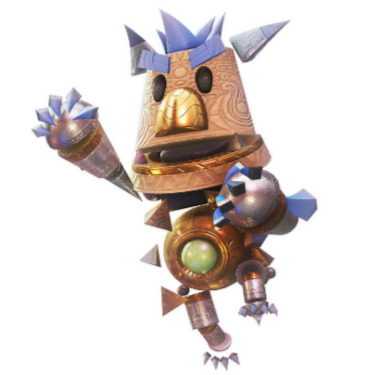
Unlike in Knack 2, this temporary vessel will mimic physical traits of the soul when using relics to increase their side. Their Sunstone powered abilities also change to fit the respective fighting style. When combining with Knack like in the game's Co-Op, the appearance and abilities are much closer to an actual fusion.
There is one more detail I sorta forgot to mention. Should Knack be in a area heavily saturated in Relic or Sunstone Energy than the spirit within his chest becomes visible to everyone around him. This 'form' acts more like a phantom as their voice can be heard but they can't interact with the outside world.
Now with that outta the way, we can truly get started.
Jonathan Joestar

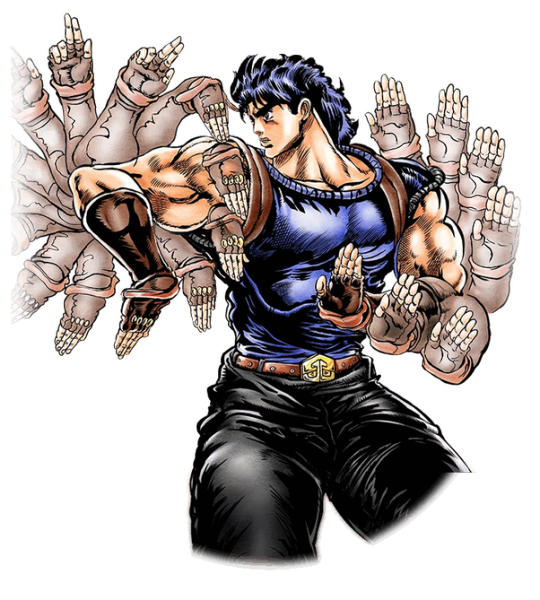
Figured I start with a pick from an older fandom I'm in: JoJo's Bizarre Adventure. Couldn't resist the irony of an archaeology enthusiast awakening inside sentient ancient relics. Jonathan isn't fully aware about this new situation at the start.
His mind's really hazy during Chapter 1 of the first game. Jonathan barely get a few snippets from Knack's viewpoint so he's heavily confused about this new situation. Unlike the other picks, he becomes conscious much faster due his and our golem hero's powers being connected to sunlight.
Not exactly a good thing as frequent vision obscuring illusions(memories) throughout very hostile uncharted territory full of bottomless pits is an awful combination. Or that it makes your allies concerned about unknown glitches being left unnoticed until now. Doctor can't exactly reboot Knack.
The first swap between both souls occurs during the boss fight against the Goblin Chief. For those unaware, there is a unique martial arts in JJBA called Hamon. A breathing technique which allows one to channel sunlight like energy for various effects from healing to enhancing one's own weapons. Combine that with a golem who can channel sunlight into different forms of destructive attacks and you got a lethal force to be reckoned with.
Knack is essentially the perfect vessel for Jonathan to take his Hamon to unimaginable heights. The golem however was a bit rattled upon seeing the Goblin Chief's mech utterly destroyed in a blink of an eye(to him). A black out that continues to happen even more frequently.
Doctor and Lucas being the only ones to help piece together this strange new personality for Knack to understand. Though the story Jonathan tells is very bizarre to them with his evidence being the Hamon technique. A stone mask that turns those who wear it into an eldritch vampire and a evil foster sibling that uses said mask for world domination.
Now neither souls has seen their shared body so Jonathan is a bit suspicious about everything that has happened so far. (He thinks he is in a trap made by Dio.) At least until the golem gets tossed into the ravine and sees the spirit. Jonathan's phantom like form visibly apart from Knack's own destroys the remaining doubt.
It takes until final boss of the first game for both to become in sync. Jonathan still has difficulty trying to adjust to this new reality. You have to remember that his psychotic vampiric foster brother is loose in his world and completely unaware of what he's up to.
Knack does try to ease Jonathan's worry, usually letting the man take control so he could take a walk or blow some steam. The Joestar is quite happy once the Doctor creates his vessel as he won't lie that being cooped up without a body tends to suck. He does miss his old one but makes it work in the end.
At least Jonathan can officially try to become an archaeologist! He can't exactly stay far away from Knack but studying relics goes hand in hand with his work. A win-win situation although Jonathan might have a few bumps in the road.
Those being Knack 2 but also a destined encounter involving his past and the bloodline he left behind...
Sparda

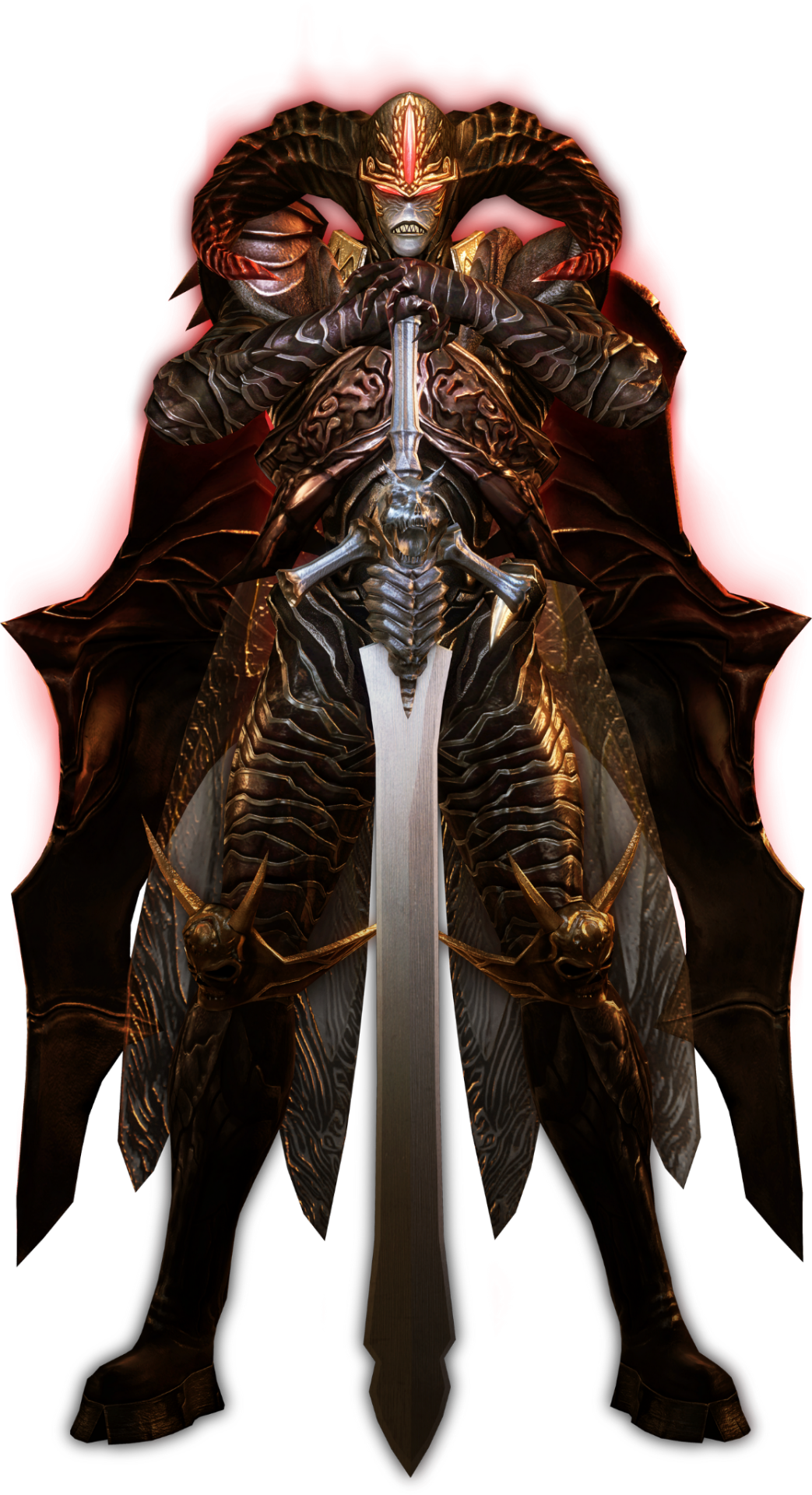
I figured the next pick would be a character who I haven't experimented with that much. Plus someone needs to kick this devil's ass into gear at some point. Why not shove the Dark Knight's soul inside a the core of a little size shifting golem.
It takes longer for Sparda to gain consciousness since devil spirits take a bit longer to fully connect to a non human vessel. This has led to his power seeping out on occasion. Knack often finds his attacks or abilities more destructive than normal. Only warning anyone has is the chest orb's crystal flashing violet.
First swap happens at the very start of Chapter 4 once Knack connects with the giant relic in Viktor's mansion. Sparda is super confused and concerned about this new situation. He is unaware of what to his wife nor kids.
This body has another spirit inhabiting it whose already on their own respective mission. Sparda helps the group nonetheless as it may lead to more answers. Knack's a bit conflicted about him considering most of the memories he seen from the devil are quite gruesome. (Devil May Cry games in general very violent plus it took some time before Sparda decided to fight for humanity.)
It took quite awhile for Knack to become accustomed to the more brutal memories but does decide to trust Sparda in the end. He feels less instinctively isolated with the devil around from how different they are to others. A feeling that allows them to fully become in sync around Chapter 10.
Once the temporary vessel is made, Sparda's routine sums to wandering, reading or training. It is the only thing to keep him from overthinking about the family he left behind by his death. Knack does try to help Sparda with his worries even if the most the golem can do is reassurance.
The devil does drag Knack into some of his work routines which includes swordsmanship. He figured it would do some good that the young hero expands his skill set as he really doesn't have a fighting technique at all. Sparda stills retain some of his magic and often contemplates about making new Devil Arms from it.
He often tests the Doctor's new inventions mainly out of curiosity. A great way to spend some time but also experiment with the possibilities. Sparda wonders if he can incorporate Sunstones into magic or creating Devil Arms.
A thought that might decide whether the two will be ready for their new adventure. Or when the time comes for Sparda's past comes to show itself. Guess it's time to pull that Devil Trigger.
Tangeth Toborn


I decided the final example should come from a series that has faded into the background for a decade, Chaotic. The heroic lion-like Overworlder who gave up his life to save the world of Perrim: Tangeth Toborn. Lore wise, he came from a place called the Spiritlands and could only exist outside the realm through his weapon, the Sword of Kh'yat.
A blade later broken to summon him when a dangerous threat from said land came to attack Perrim. Taking this tidbit into consideration, he's the second fastest to gain consciousness as his spirit still had issues adjusting to Knack's chest orb. It did speed up the bombardment of visions between Tangeth and his new host.
Knack had to take a short break multiple times as the memories were so vivid to the point he gotten minor dysphoria. Lingering taste of foreign food, the stickiness on matted bloody fur, and hot flames that burn his flesh. Tangeth wasn't having fun either as it became apparent he's in the human world. Or at least some variation of it. (First Creature on Earth!)
First switch during the boss against the Goblin Chief like in the Jonathan scenario. Tangeth uses fire and earth elemental attacks which took some time to learn how to use again since Knack wields solar based energy. He also wanted to know the entire situation before he willingly decides to help the Doctor and Lucas.
Tangeth truly begins to open up during his shared time with Knack down in the ravine. Chaotic Players(humans) have often caused chaos for his tribe to the point that some were willing to destroy precious locations for personal gain. Knack is the only person who's able to get Tangeth to at least give this new world a chance.
Both fully synchronize with each other halfway through the last chapter of the first game. Tangeth adjusts very quickly to the prototype vessel the Doctor creates much faster than expected. He does have experience with soul binding artifacts after all.
Tangeth usually spends his time reading, exploring or training. He has some difficulty trying to adjust in a world with way fewer conflicts between its nations unlike back in Perrim. Tangeth later asks the Doctor to make him a new sword, one powered by Sunstone he calls Kiru. He swore a new oath on the blade that he protect this world from danger.
Tangeth has a tendency to drag Knack into his training sessions as he also believes the golem should learn some actual fighting styles. Why waste such potential with just simple punches and kicks? Yes, Knack ate dirt a few times cause Tangeth was a general for an army before his death so no holding back.
It definitely helps when the next adventure proves itself to be much harder than the last. Or the possibility of a certain dream episode could potentially come true in this reality. No worse way to test loyalties.
At least that's how I see all these particular scenarios.

#sonicasura#knack#knack 2#ps4 knack#knack series#knack ps4#knack 1#vessel!knack#vessel knack#jjba#jojo no kimyou na bouken#jojo's bizarre adventure#jojos#jonathan joestar#part 1 jonathan#sparda#dmc sparda#devil may cry#devil may cry series#dmc#dmc series#tangeth toborn#chaotic#chaotic series#chaotic card game#chaotic tv show#i got bored
8 notes
·
View notes
Text

DEALERNUT AU: A Evil & Good Frisk/Kris (2024)
------------------
[Note: it might be best to click on this to make it bigger...this will be used as a Cover for a future chapter in "Dealernut AU: The Fragmentation Of LOVE" on Quotev, but it is not likely many will be interested in reading it right away, and I'm fine with that. I have that story on hiatus at the moment...so yeah, this drawing will before both here and over there...]
Credit for Undertale & Deltarune goes to Toby Fox
-----------
this drawing has to do with a Fan-Headcanon and theory.
that the Good-Frisk & Kris are In-Game Players, not us the Player that lives outside the Universe of Undertale and Deltarune.
the In-Game Player lives in a world, where their world is more connected to both Undertale and Deltarune than ours is, so their red soul ends up in Frisk, who's true self is cold heart apathetic human child who in the true timeline they are from when they start in Hard Mode Route, they ended up with a lot of LV...
the In-Game Player that becomes the Good-Kris, they at some point like Frisk did, had to share control of their body with the Outer-Game Player...
the strings that connects In-Game Player/Frisk & Chara's Souls together, as well as In-Game Player/Kris and the Turquoise Souls.
the Turquoise Soul could turn out to be a Artificial Soul that was made to inhabit Kris's body before the In-Game Player ends up being placed into Kris's body, even after we the Outer-Game Player try to make a Vessel for the In-Game Player.
Turquoise Soul Kris, could be good and keeps to themself, and doesn't pull the same pranks as the Original True-Kris...
the reason why Kris has to share with with a In-Game Player Soul,
is to keep the Original Kris from taking back full control,
while Kris with the Turquoise Soul has the same memories as the Original True-Kris, they may not remember everything the Original does...and they may not know that they are not the original, but their true self is a Artificial Soul that was created to keep the Original-Kris from resurfacing...
Kris and Asriel's Parents could of had this done, because they notice how dangerous and violent Kris was getting as the years went by, at first things seemed normal and less violent, but then there could of been a incident that had them take drastic measures.
and it had involved placing a new soul in Kris, to keep their dark side in check so they don't hurt themself or anyone.
we know that Chara is always used a scapegoat, but we know that True-Frisk is probably the one that is the one that ya need to watch out for...like even if we the Outer-Game Player isn't doing a Reset, True-Frisk ends up doing them, taking full control back from the In-Game Player that we know as "The Good-Frisk"...
Chara could be very aware about the true nature of the original Frisk, since they saw them turn monsters to dust in the Hard Mode Route.
and unlike the Outer-Game Player, who didn't get to leave the Ruins...
True-Frisk did and they kept turning monsters into dust as they kept through the underground until they got to the King's Castle.
and for the whole Paradox thing, before True-Frisk could do any harm to the King, they are stop by Gaster who then takes them to the secret true lab that at some point ends up between time & space...
and when the Good-Frisk ends up in that lab, they end up seeing their reflection in one of the rooms, but it isn't their reflection, it's them or rather it's the Original-Frisk, who is too dangerous and has too high of LV to be let free into the world of both the underground and surface.
Alphys might not know that the secret true lab is in between time & space, and may be connected between Undertale and Deltarune's World...anyway the story that involves The Dealernut AU, might end up being in a long hiatus, and I can take my time on it and it doesn't need to be a long story, plus I kind of want to add other worlds into it along with Undertale and Deltarune, like Steven Universe for one.
anyway I will post up another drawing in a little bit, right after I do something first...anyway if some do wonder about the name of that AU...it is also can be the same like Deltarune and Undertale,
meaning all you have to do is mix Dealernut around and you will either get Undertale or Deltarune...it is Dealer-Nut, which could hint that Spamton will play a part in that story in the future...
cause he may technically be a Dealer and he's kinda Nuts. XD
#do not reblog without permission#crossover au#undertale au#deltarune au#undertale fanart#deltarune fanart#dealernut au#fan headcanons#frisk undertale#chara undertale#kris deltarune#good and evil#alternate universe#march 2024
15 notes
·
View notes
Text
Ralsei Speculation
Who, and what, is Ralsei? There's a lot of mystery that remains there, and it's a fun thing to think about.
I suspect that Ralsei is Kris's ideal self, cast from what remains of their soul after the player's invasion of Kris's body. I also believe that Kris discarded their soul quite intentionally. What remains of their bodily autonomy is working in conjunction with Ralsei to accomplish some goal that is kept secret from the player. Frankly, I suspect the Deltarune prophecy itself is a lie fabricated to lead the player along in ignorant cooperation with that objective, whatever it may be.
There are a few key moments where it seems that Kris is deliberately keeping information from the player by exerting some level of control over their body, and in which Ralsei has conversations with Kris in the player's absence. It's also rather odd that Ralsei clearly benefits from the opening and subsequent sealing of dark fountains. One would suspect that, given Ralsei's faith in the gang and desire for companions, he would encourage the opening of additional fountains. They can be closed quickly, so no worries, right?
I think that is resolved when you note that there is some odd -- and, I suspect, deliberate -- inconsistency regarding who has the power to close dark fountains. Ralsei has gone between saying any lightener can do it and that only Kris can do it. I think both of these statements are true- with the caveat that only the lightener who opened a particular dark fountain can close it. Kris, having been responsible (in my view) for all three plot-relevant fountains so far, is also solely capable of closing them, and of reaping the benefits for themself and their dark world counterpart, Ralsei.
I also have a sneaking suspicion that the act of opening a dark fountain sets the soul loose and creates a new dark prince. Kris opened the fountain at the school, and in doing so made their body an empty vessel suitable for possession by the player. They probably would have died, if not for the player's connection. This provides another justification for discouraging the other lighteners from opening dark fountains, creating the myth of the roaring to avoid letting the player in on some of the more locally/personally existentially horrifying parts of the plot.
I think we get even more support for this idea that Ralsei and Kris are two parts of the same whole from (and I feel silly writing this, but) tea theory. A good friend's tea heals for 120 points. Noelle's tea heals Kris for 70 pts and Ralsei for 50 points. Summed? 120 points. Conversely, Noelle is healed 70 by Kris tea and 50 by Ralsei tea. 120 points, together. Possibly a coincidence, but I choose to believe it's intentional.
~~~~~~~~~~~~~~~~~~~~~~~~~~~~~~~~~~~~~~~~~~~~~~~~~~~~~~~~~~~~
There is one thing that I find interesting, however, which could upset many of the underlying assumptions made above. To my knowledge, no character in the game has ever described Ralsei's appearance, outside of being shocked by it or expressing familiarity. Noelle says, "it looks kind of like..." and trails off. You are expected to mentally finish that sentence with "Asriel", but it is deliberately cut short. I don't recall Susie ever saying anything about Ralsei's resemblance to the members of the Dreemurr family, despite having had Toriel as a teacher. There is a possibility that the dark prince has an appearance which reflects something about the being beholding it.
Perhaps the beholder's idea of an authority is presented. Kris's parents, Noelle's mother - and though we know little of Susie's home life, we do know that she doesn't care much for being bossed around. Or perhaps the dark prince seeks to gain emotional leverage by taking a form similar to someone their observer misses. Asriel, off to college, or... Dess...
I know, I know, I'm painting the fluffy boy in a negative light and I fully expect to be roasted for it, if this post is even noticed by anyone. Just know all of this is a fair bit nicer than my previous model for Ralsei, which I think is best summed up by the phrase "soul parasite". Maybe I'll elaborate on that concept later.
5 notes
·
View notes
Text
Plug In and Play: The Emotional Energy of the Electric Guitar
More Than Just an Instrument
The electric guitar isn’t just a collection of wires, wood, and strings—it’s a vessel for emotion. With just a few chords, it can stir nostalgia, ignite passion, or echo heartbreak. Few instruments carry the same level of expressiveness, allowing the player to transmit feelings directly through their fingertips. Whether you’re channeling raw aggression through distorted riffs or exploring delicate melodies with clean tones, the electric guitar gives you an unmatched level of emotional control.
Its magic lies in its dynamic response. From a soft whisper to a thunderous roar, the guitar reacts instantly to your intent. And that’s precisely why it continues to inspire new generations of musicians.
Bridging the Gap Between Analog and Digital
In today’s fast-paced digital age, where music is often created with virtual instruments and pre-made loops, the electric guitar bridges the gap between tradition and technology. Paired with modern gear like digital audio interfaces, amp simulators, and recording software, the guitar’s analog charm blends seamlessly into digital production environments.
Musicians no longer need to rely on expensive studios to craft world-class sound. With a single guitar and a creative mind, tracks can be composed, layered, and shared globally. This accessibility has made the electric guitar a central component in home studios, empowering independent artists and bedroom producers to reach audiences without limitations.
A Soundtrack for Every Genre
The electric guitar’s role isn’t restricted to rock or metal anymore. It has found a place in nearly every genre of modern music. Jazz artists use it for smooth, warm tones. Indie musicians create dreamy soundscapes with reverb and delay. Even in hip-hop and electronic music, guitar samples and live recordings are used to add an organic feel.
This genre-blending capacity makes it one of the most versatile tools in music today. For players who want to explore multiple styles—or fuse them into something entirely new—the electric guitar offers a limitless platform for experimentation.
Design That Matches Ambition
Choosing an electric guitar is a personal journey. It's not just about sound—it's about feel, look, and connection. Some players are drawn to vintage-inspired models with classic finishes, while others gravitate toward futuristic designs with sleek contours and advanced features. The market today offers a stunning range of options for beginners, hobbyists, and professionals alike.
Build quality, tonewoods, pickup configuration, and neck shape all contribute to a guitar’s character. But more importantly, it’s about how the instrument responds to your energy. The right guitar doesn’t just complement your style—it enhances your creativity and motivates you to keep playing.
An Invitation to Start Something Great
Learning the electric guitar isn’t just about playing music—it’s about personal growth. It builds patience, discipline, and confidence. It encourages experimentation and storytelling. And as skills develop, so does the sense of accomplishment. Whether you’re performing live, recording solo tracks, or simply jamming in your room, the guitar offers an endless source of inspiration.
And perhaps the most beautiful part? There’s no one “right” way to play. Some chase technical perfection, others focus on feel. Some stick to the classics, others break every rule. The electric guitar welcomes them all.
Final Thought
As music continues to evolve, the electric guitar remains a timeless source of passion, creativity, and expression. It speaks every language, fits every genre, and resonates with anyone willing to explore its depth. For musicians ready to take their first step or seasoned players seeking their next great sound, there’s nothing quite like the experience of picking up an Electric Guitar in Qatar.
0 notes
Text
Cupping For Sports Injuries and General Health
Cupping is a form of alternative medicine that is in practice for ages. This holistic therapy dates back to as early as the 4th century! It is widely looked into and considered in the past few years, as Cupping became popular among sports & movie personalities.
One of the most famous celebs who used Cupping was the 28th-time Olympic gold medalist, Michael Phelps, who displayed his bruises during the 2016 Olympic Games in Rio de Janeiro, Brazil. Other celebrities like Gwyneth Paltrow, Victoria Beckham, Justin Bieber, Kim Kardashian, Jennifer Aniston, and Padma Lakshmi swear by the cupping therapy and its benefits. Athletes all over the world from Wang Qun in the 2008 Olympics to tennis, Badminton players all talk about how cupping therapy has helped them perform better. Mets’ players like Daisuke Matsuzaka, Matt Harvey, Bobby Abreu, and Jacob deGrom reveal how the therapy, when used in combination with other forms of treatment, has helped them heal from injuries and also speed up the recovery process after they have had surgery. This not only helps you to cure suffering, but it also helps you to prevent sports injuries. It is also considered a new go-to treatment to look ageless and do away with aches and pains in therapeutic, relaxing sessions. It is quite popular among athletes as it increases blood supply to a specific area & helps heal sore, & tired muscles.
What exactly is cupping?
Originating in Egyptian, Chinese, and Middle Eastern cultures, Cupping involves placing cups on the skin to create suction. Suction facilitates the flow of "Qi" (Lifeforce)in the body. It enables healing as it increases blood circulation to the area in the cupping region. Cupping alleviates muscle tension, and improves overall blood flow, and promotes cell repair. It enables the formation of new connective tissues and creates new blood vessels in the tissue.
Cupping helps balance yin and yang(negative and positive) within the body. Restoring the balance between these two helps the body's resistance to pathogens and its ability to increase blood flow and reduce pain.
Cupping helps treat conditions like muscle pain and tension, Reduced joint movement, Headaches, Back pain and sciatica, stress, anxiety, etc.
It helps to prevent muscular catch, pain, and weakness - the reason why the sportsmen and athletes prefer to get done very frequently. Cupping can be done for general health and any chronic and acute muscular pain.
What are the benefits of cupping?
Since Cupping is used for a deep-tissue massage, it helps in relaxation & overall wellness.
Cupping helps treat pain and injury.
Cupping therapy removes toxins, dead cells, lymph, impurities, & other debris from the body.
It removes disease-causing pathogens.
Cupping therapy is popular with athletes as it heals the injuries by removing the stagnant blood & improves blood circulation. The replaced fresh blood is rich in oxygen & nutrients & it rejuvenates the body.
It works wonders for people suffering from colds, flu, coughs, allergies, fevers, acne, facial paralysis, herpes zoster, & cervical spondylosis.
Highly beneficial for people suffering from:
Blood disorders like anemia & hemophilia
Rheumatic diseases such as arthritis & fibromyalgia
Fertility and gynecological disorders,
Skin problems, high blood pressure, migraines, bronchial congestion, and varicose veins.
It is also known to be a solution for anxiety, depression, and insomnia.
Cupping therapy aids weight loss and cellulite treatments.
Dry Cupping
Dry cupping helps increase the blood flow and induces a stretch effect, which results in a reduction in muscle tension and associated pain. During the cupping session, the cups can either be left in a static position or be moved to achieve a good flow of blood in the tissues. This cupping therapy complements other therapies like Sports and Deep Tissue Massage, Dry Needling, and Acupuncture. Dry Cupping helps alleviate soft tissue injuries and reduce pain or discomfort.
How does Dry Cupping work?
A cup is placed on the skin during a cupping treatment and then suctioned onto the skin. When the cup is placed on your skin, the air inside the cup creates a vacuum that draws the skin and muscle upward into the cup. Your skin may turn red as the blood vessels respond to the change in pressure.
The vacuum creates suction to lift soft tissue and blood to the surface. This affected tissue then becomes saturated with fresh blood. The saturation results in new blood vessel formation and increases the nutrient and oxygen content within the affected area. Thus often leaving behind a circular mark, which disappears after a day or two. Due to this vacuum effect, the body responds by stimulating an inflammatory response, which promotes natural healing ability within itself. The body now releases white blood cells, platelets, and fibroblasts to initiate healing.
Finally, the stretch produced within the soft tissue and fascia results in a muscle relaxation effect, which ends up an improved range of motion and performance.
The cupping type to be performed is decided by the practitioner based on your medical condition & your preferences.
Who can benefit from cupping?
Athletes and sportspeople - Our entire Cricket Team swears by it.
Bollywood and Hollywood celebrities to keep them looking young and fit.
Couples looking to conceive a child of their dream.
Those suffering from pains and spasms in the body.
Cupping is one of the most therapeutic presents in the world. With its growing popularity, many people have started opting for it to prevent and cure injuries both acute and chronic in conditions.
What about the side effects of Cupping?
Cupping doesn't have any side effects.
Many individuals who are planning for a cupping session are worried about the bruises or the cupping marks. This is not common to all. The marks you see indicate that the harmful toxins and pathogens are brought to the surface. The colour of the cupping marks differs according to the toxic level in a specific area of the body. A lighter shade indicates fewer toxins or stagnation, while a darker hue means a higher level of it. The light cupping mark's colour disappears within 2-3 days, whereas a darker colour would take about a week’s time.
Several holistic treatments can be used to improve wellness, but cupping therapy in Bangalore is very promising with its long list of health benefits
0 notes
Text
ChatGPT
Birthed from over two decades of relentless artistry and devotion, the Ellis Dreadnought Guitar is not just an instrument—it’s a masterpiece of sonic alchemy. Like the waves shaping the coastline, every curve, contour, and tonewood selection is honed with purpose, steeped in tradition, yet daringly modern.
Its voice? Immense yet intimate, delivering a resonance that feels alive. Rich, balanced lows roll like the tide, while crystalline highs dance like sunlight across the water’s edge. And within, an energy—a soul—crafted for the hands of those who command the stage or cherish a quiet moment in solitude.
Built by hands that have shaped guitars for the world’s most iconic players, the Ellis Dreadnought holds within it a promise: to elevate your sound, and with it, your connection to the music you make. Like the finest elixirs, its beauty deepens with time, creating a partnership as enduring as the music itself.
This is not just a guitar—it’s a journey. Crafted for those who understand that true artistry begins with the tools you trust.
The Ellis 000 Guitar is a testament to precision, elegance, and the pursuit of perfect tone. Refined and responsive, it’s designed for those who crave a close connection with their instrument—where every nuance, every touch, is amplified into pure musical expression.
Its smaller body exudes intimacy, ideal for fingerstyle players and storytellers who demand clarity without sacrificing warmth. The mids sing with a rich, vocal-like quality, the highs shimmer with crystalline brilliance, and the lows—anchored but never overpowering—form a foundation as steady as the craftsman’s hand.
Every detail of the Ellis 000 is intentional. From the hand-selected tonewoods to the flawless joinery, it embodies over 20 years of expertise and the passion of a maker dedicated to sonic excellence. Lightweight, comfortable, and endlessly inspiring, this guitar becomes an extension of the player—a conduit for creativity, whether on stage, in the studio, or in the quiet corners of life.
The Ellis 000 isn’t just a guitar; it’s a partner in your artistic journey, a vessel for your voice, and a promise that the music you create will resonate for generations.The Ellis OM Guitar strikes a masterful balance between power and precision, offering a tonal palette as dynamic and versatile as the artists it inspires. Designed for those who demand both presence and nuance, this orchestra model marries the clarity of a smaller body with the depth and projection of a larger one.
Its voice is unmistakable—crisp, articulate trebles dance effortlessly over a foundation of tight, punchy lows, with a midrange that blooms with warmth and color. Whether played with a delicate touch or driven with intensity, the Ellis OM responds with unwavering clarity, capturing every subtlety of your style.
Crafted from the finest tonewoods, its sleek, perfectly proportioned body ensures both comfort and playability, making it an ideal companion for fingerstyle intricacy, flatpicking finesse, or dynamic strumming. The meticulous craftsmanship—shaped by decades of luthiery expertise—imbues this guitar with a soul that resonates deeply with players and listeners alike.
The Ellis OM is more than an instrument; it’s an invitation to elevate your artistry, a tool for discovering new dimensions of sound, and a testament to the enduring magic of hand-built guitars.
0 notes